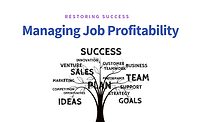Restoring Success: Job Descriptions Made Simple

All hands on deck. At any time in the world of restoration, it is all hands on deck mode. The industry is changing rapidly and the priorities of the day are often defined by what is happening in the moment. For this reason, many feel challenged, burdened, or stifled by the concept of job descriptions.
Most restoration companies appreciate team members who simply get done whatever needs doing and have an aversion to job descriptions that may limit desired performance outcomes. However, job descriptions are important for a variety of reasons:
- Hiring: Initial advertising, recruiting of new hires, and interviewing.
- Training: A training path and objectives are based on the description of the job.
- Accountability: Evaluations, disciplinary actions, growth, and development are based on a person’s ability to perform the job (as described), or work toward another job (as described).
A job description does not need to be a detailed list of specific functions, but more a simple objective-based description with some qualifications that effectively communicate a role. Check out this outline:
- Job Title: A brief summary or statement can be developed to support the title.
-
Primary Responsibilities: It is recommended that this is kept as a simple presentation of responsibilities that make up the majority of the duties. Key references can assist in providing detail and expectations and allow the description to stay concise. These supporting documents may include:
- Best Practices
- Standard Operating Procedures
- Employee Manual and Safety Policy
- Shared Values
- Objectives and Metrics
- Service
- Quality
- Profitability
- Timeliness
-
Qualifications: This may involve a variety of items that fall into different categories:
- Skills, proficiency, and/or years of experience
- Physical requirements. It is important to clearly outline the physical requirements that are demanded in many positions in the restoration industry. These should be used to assess new hires based on the job description. Examples include: lifting, respirator fit, ladders, etc.
- Other: driver’s license, criminal background check, driving record, credit score, drug screening, etc.
You can develop or simplify your job descriptions to fit your needs. However, make sure they are cohesive with your company’s other supporting documents referenced above as well as your performance reviews and other documents, programs, and so on.
Now that we’ve taken a broad look at job descriptions, I’ve created a few more specific examples. These are meant to illustrate a general approach to creating and/or implementing job descriptions that can work for you. The supporting documents that are referenced should be front and center at all times so there is no confusion as to the specific expectations. Customer service quality objectives are the types of items that can detailed out in the supporting documents or included by detailing out the responsibilities further.
Job Title: Restoration Technician
Primary Responsibilities: Deliver a variety of restoration services in accordance with company standards, objectives, and policies.
Qualifications: Must be drug free, clean criminal background, driver’s license, and be fit to wear a variety of respirators, able to lift 45 lbs.
Job Title: Production Manager
Primary Responsibilities: Manage and develop company resources in accordance with the company’s core values, best practices, and policies in serving our customers. Resources include but are not limited to: equipment, vehicles, staff, subcontractors, and facilities.
Qualifications: Must be drug free, clean criminal background, driver’s license, and be fit to wear a variety of respirators. Proficient on a variety of computer software, possess 5 years minimum of restoration/construction or related experience, and have a minimum of 5 years of management experience. Effective written and verbal communication skills.
As with many specific areas within our organizations, the overall value and effectiveness of your job descriptions will be influenced by your culture and supporting systems.
Looking for a reprint of this article?
From high-res PDFs to custom plaques, order your copy today!








